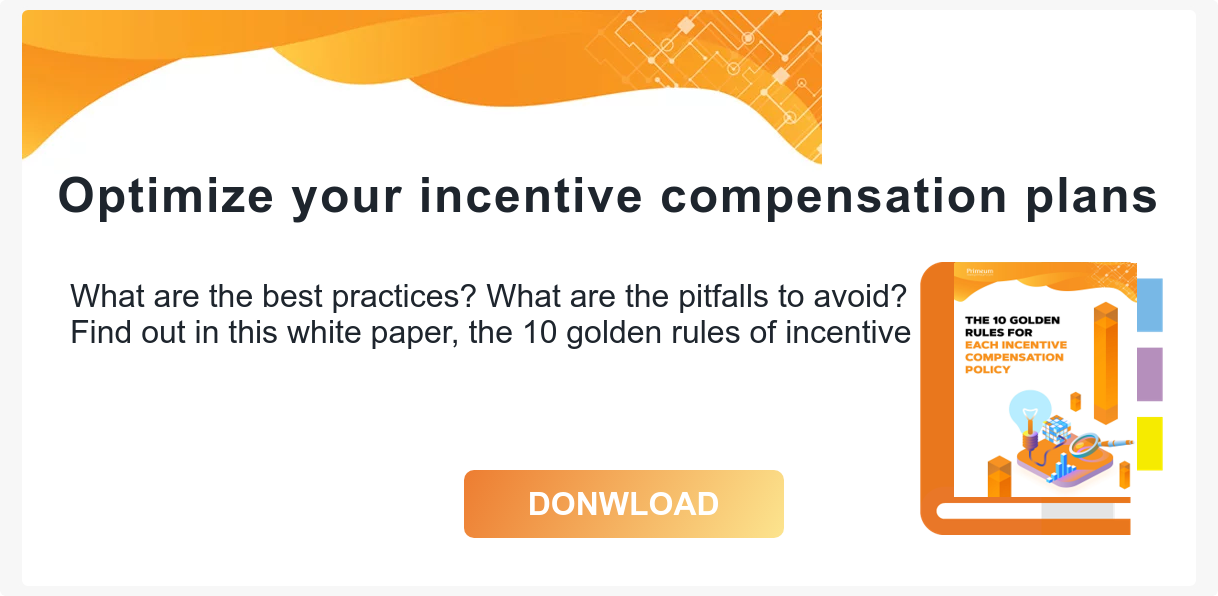An employee’s remuneration is not always limited to their fixed salary. The employer may pay various individual or shared bonuses to supplement it. These include the Macron bonus, attendance bonus, seniority bonus and activity bonus etc.
On what basis are these different bonuses paid? How do you distinguish between compulsory and optional premiums? How do they help motivate and retain employees, but above all recruit them against the backdrop of a talent war? In this article, you will find a comprehensive overview of the various existing bonus schemes!
What is a bonus?
Definition of a bonus
Variable pay, also known as performance pay, is made up of bonuses. The bonus, which varies according to the position held by the employee, is intended to compensate for performance achieved and may be individual or shared.
In addition to individual salary increases, the company seeks to promote employee commitment through various remuneration mechanisms, including sales commission, bonuses and also target-based bonuses.
Individual bonuses aim to maximise the results of the employee’s work and can take several forms, such as the number of parts produced by a technician, the number of customer accounts opened by an account manager or the number of sales made by a sales representative. In addition to the individual bonus, the employee can benefit from a shared bonus system which rewards the results of a team as a whole.
The different types of bonuses
Commission bonuses
Commission is a form of incentive compensation that depends on results. Commission bonuses can thus be indexed to turnover before tax, quantity sold and gross margin etc. They are based on the principle “the more I sell, the more I earn”. Commission is rarely capped, which can be a unique source of motivation for salespeople who receive a percentage of the turnover or margin achieved in a linear fashion.
The principle often applies from the first euro sold. This practice is often found in small organisations. Commission has the advantage of being easy to implement and easy for sales teams to understand. It can also be very appropriate for networks of all sizes with a strong sales culture, where the sales staff are fully responsible for the act of sale without the involvement of other teams.
Performance bonuses
A performance bonus is a form of variable pay which is particularly suitable for functions where it is easy to define clear and consistent targets. It is therefore the best pay solution for positions when it is possible to set a precise standard of work linked to a clear level of performance.
In addition, performance bonuses makes it possible to differentiate between different levels of customer satisfaction requirements, thus offering the possibility of assessing both the quantitative and qualitative aspects of the work performed. Performances bonuses mean recipients can be paid according to a specific target, as opposed to commissioning, where each recipient receives a set percentage of an overall result. Finally, with performance bonuses, the employee’s performance is based on their ability to meet and exceed targets and is assessed in terms of actual achievements measured against predefined targets.
Ranking bonuses
Ranking is the easiest way of paying variable compensation. It simply consists of classifying employees, usually salespeople, according to their performance and paying them a ranking bonus based on their rank. The advantage of ranking is that sales managers can control the budget spent on ranking bonuses from the outset.
However, ranking bonuses are rarely used because they have one major disadvantage: they turn the achievement of targets into a business game. Not only do they fail to encourage the promotion of certain qualitative targets such as customer satisfaction, but they also tend to create competition between sales staff which can be detrimental to the success and efficiency of the entire team. As such, this method of remuneration is used more for incentives such as bonuses in kind, gifts and cash.
Challenge bonuses
Challenges and incentives are the most common facilitation tools used by companies wishing to motivate their sales force. Popular in certain sectors like retail, they aim to motivate and mobilise teams faced with an opportunity to be seized or a difficulty to be overcome.
Companies that implement challenges remain flexible in terms of the choice of performance criteria. Depending on the commercial stakes or activities deemed to be a priority, challenges provide the opportunity to clearly highlight the areas of performance employees should be geared towards. In addition, challenges offer a reasonably clear picture of performance reflecting each individual’s progress, so are connected to a challenge bonus.
Quantitative or qualitative bonuses?
Quantitative bonuses, the most widely used bonus
The procedures for allocating quantitative bonuses are relatively clear because they are linked to concrete results. They are received as soon as quantitative targets are achieved. They are very widespread in the retail sector and are becoming widespread in support, marketing, HR and finance functions. Furthermore, they are no longer only offered to sales staff.
However, it would be dangerous to objectify sales representatives based solely on their quantitative performance. Indeed, as the aim is to motivate them to make sales on a regular basis, rewarding them solely on the basis of individual, one-off and purely quantitative criteria can be counter-productive in certain situations.
Qualitative bonuses are becoming more and more on trend
A incentive compensation system can be based on both quantitative performance bonuses and qualitative bonuses, for example by rewarding the employee’s behaviour in a team or department.
For a salesperson, for instance, the idea is to add other evaluation grids to the individual quantitative criteria, highlighting aspects that are more closely linked to their behaviour. These aspects include their involvement in a team or within the company, their initiative in group-wide projects, their commitment, their ability to share information with colleagues and how well they collaborate with other departments etc.
As qualitative criteria are still difficult to measure today, objective elements need to be used to evaluate the action taken. Tools such as evaluation grids or scorecards can therefore provide the most objective initial approach possible.
Management by objectives (MBO) is a performance management approach that aims to reconcile the objectives of employees with those of their organisation. Conceived by Peter Drucker (who is known for his work on management), the aim of MBO is to determine common objectives and to provide feedback on the results obtained. The most important qualitative measurements and MBO are performed in company headquarters, particularly management committees, which are partly indirectly accountable for the economic result. The MBO mechanism therefore mainly applies to non-sales and sedentary staff.
Individual or group bonuses?
Individual bonuses, the essence ofincentive compensation
Individual bonuses can be fixed or variable. When fixed, individual bonuses are paid to employees if their results reach the set objective. Individual bonuses can also be variable; the better the employee’s performance, the higher the bonus. In general, individual variable bonuses are capped so that there is no risk of encouraging the employee to surpass himself. However, for sales staff in particular, it is not uncommon to see uncapped individual bonuses, which encourages them to surpass themselves to maximise their earnings.
Group bonuses, to be used sparingly
Group bonuses are effective in encouraging teamwork, but the system of indexing part of the variable to shared or collaborative objectives has a major drawback: it is similar to profit-sharing, a mechanism that already remunerates commitment and overall involvement in a particular activity.
Moreover, the system that values shared objectives makes it difficult to distinguish the employees who make the most effort and thus reward them for their heavy involvement. Indeed, individual work is overlooked as thoughts turn to teamwork carried out by a team sometimes with several different functions. As a result, it is not easy to reward each individual for their actual investment when group bonuses are paid.
Bonuses best avoided
Discretionary bonuses
Known as “discretionary bonuses”, “managerial bonuses” and “bonus at the discretion of the manager”, discretionary bonuses have different names but are always based on the same principle: a manager is solely responsible for allocating them and determining their amount.
Many employees have been confronted with them and sometimes rename them “subjective bonuses” or “customer discretionary bonuses”. In a discretionary bonus system, the employee has to work hard without knowing whether they will be paid, which is counter-productive and demotivating. Discretionary bonuses do not give employees the chance to assess themselves, whereas increasing motivation through variable pay for an individual is the result of “stretching the pay system”. The latter is therefore essentially the result of the possibility of obtaining a big gain combined with the risk of losing.
For the system to be effective, the employee must therefore be able to imagine achieving their individual performance target and know the exact results according to the how much effort they make and how they are translated in terms of achieving set objectives and finally the bonus amount. Such conditions are incompatible with the principle of a discretionary bonus.
Loyalty bonuses
Loyalty bonuses are designed to retain employees. They should not be based on a random allocation system and should therefore not be part of an unfair system. Loyalty bonuses are an effective solution in the short term, but should be supported by long-term salary increases that reward loyalty and seniority.
Why use bonuses?
To motivate teams
Variable pay is highly valued by companies and no longer only concerns sales staff. Rewarding performance and results, it is a serious motivational tool.
To further motivate employees while taking into account their individual results, employers can vary their overall remuneration by influencing the share dedicated to variable remuneration.
The criteria used to calculate bonuses or performance bonuses are based on objective, factual elements that are agreed annually with the employee. As such, according to these pre-established performance indicators, it is possible to supplement an employee’s salary by paying them a one-off bonus. This action can be reversed; indeed, the bonus varies according to how well the employee achieves their targets and may be cancelled if these targets are not achieved.
incentive compensation is therefore a major advantage when it comes to motivating and rewarding deserving employees. As this additional remuneration is closely linked to the achievement of targets, it is ideal for rewarding good results over a year, for example.
To create recognition
Recognition at work, which is an important motivating factor, has a greater effect if it is coupled with adequate incentive compensation. However, setting targets for employees is not systematically linked to remuneration. For instance, in a management accountant function, the CFO may set targets but not pay staff to meet them. Quality reports may need to be created and certain documents produced quickly etc. In the annual performance review, the manager can recognise an employee’s achievements by showing gratitude and respect, which is in line with the concept of recognition at work as a foundation of employee well-being.
Recognition at work therefore may not be accompanied by financial rewards, although recent studies on employee motivation suggest it is more powerful when it is linked to financial gains. Some French employees thus place the need for recognition on the same level as the expectation of earning attractive remuneration. Companies can therefore set targets without associating them with variable pay, though the impact on employee motivation is highly likely to be very low.
A poorly designed variable pay scheme can directly contribute to employee discontent. Indeed, some employees may feel hard done by and confused when faced with an opaque and poorly defined variable pay system. Problems in a variable pay system can be a source of disappointment for employees who may feel uneasy about a situation that is considered unfair.
A clear and balanced incentive scheme does not automatically lead to well-being, but it does contribute to greater employee buy-in. Variable pay by its very nature is based on a certain level of tension among employees, which, if well orchestrated, rewards the best performers.
To unite teams
Successful team building requires transparency and clarity on the part of the management. Thus, respect for fairness, an essential criterion to motivate staff, is the basis for good team cohesion. Likewise, understanding the variable remuneration system is essential to encourage teams to commit to a common project.
Furthermore, in a commercial strategy that emphasises repeat business, i.e. the opening of new accounts and above all retaining new customers, offering financial incentives based solely on one-shots does not contribute to a company’s real commercial development. Conversely, teamwork and information sharing between members of the same team, or even from different departments, optimises the commercial efficiency of the entire company.
Finally, a system of incentive compensation based solely on individual results can be detrimental to teamwork in a team. Ultimately, elements that enhance cooperation between employees should be included in the calculation of individual remuneration to encourage them to invest in teamwork.
For the employer brand and recruitment
Variable pay is a lever for recruitment and employer branding that is largely under-used by companies and recruiters. While the question of the remuneration system can be raised as early as the phone interview, most HR professionals or recruiters find it difficult to clearly grasp the different aspects of variable pay and it is not surprising that they struggle to highlight it in the recruitment process. However, having a incentive scheme is a real recruitment challenge.
incentive compensation attracts candidates motivated by performance. Today, companies have every interest in attracting applicants that develop a certain performance culture. Attracting high-quality candidates therefore involves offering the possibility of increasing their pay through variable elements directly linked to their individual performance. Conversely, offering only fixed remuneration – even if it is high – does not encourage employees to achieve strong performance. There would be no recognition or financial reward for this due to the lack of an existing system.
To build loyalty in your teams
While 67% of executives are considering professional mobility in the next three years to obtain higher remuneration, companies have no choice but to offer an attractive remuneration package if they want to attract and retain talent. Successfully recruiting and retaining employees with rare skills and expertise requires an attractive fixed and incentive compensation package adapted to the individual applicant.
Remunerating employees at their fair value to retain them
In her book, Rémunérations et avantages sociaux: outils et perspectives des RH (Remuneration and benefits: HR tools and perspectives), published by Gereso, Sophie Cavaliero, a remuneration and benefits specialist, stresses the importance of determining the “value” of an employee. In addition, she suggests the use of an evaluation matrix for each employee, based on the employee’s combined performance and potential. This matrix takes into account the employee’s results, their individual involvement and also the remuneration to be awarded. Indeed, according to the expert, remuneration is a core element in retaining employees, who no longer hesitate to leave a company if they feel they are not being remunerated at their fair value.
incentive compensation thus makes it possible to influence the retention of key employees who risk leaving. The idea is to offer variable pay that takes into account individual outperformance and to seek the best match between employees’ salary expectations and the salaries offered.





